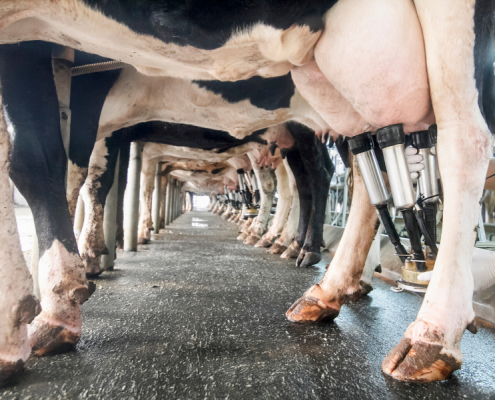How a rumen buffer drives dairy performance
High dairy performance is related to very fermentable dairy cow diets to meet their nutrient demands. Such fermentable diets lead to increased concentrations of volatile fatty acids (VFAs) in the rumen, which can accumulate leading to periods of reduced rumen pH (Whelan, et al., 2013). Hence, cattle have challenges with rumen acidosis and dairy performance is under pressure.
Formulating diets to provide adequate energy levels while also supplementing sufficient physically effective fibre to prevent rumen acidosis is extremely difficult and, in many cases, unsuccessful. Dietary mineral supplements such as rumen buffers can be very effective tools at regulating rumen pH and preventing some of the negative health and productive consequences associated with low rumen pH.
The definition of sub-acute ruminal acidosis (SARA) is a decline in rumen pH below 5.6 for more than 3 hours per head per day (Gozho et al., 2005). On farm diagnosis of SARA is difficult. The most common method of diagnosis is through rumenocentesis carried out 2 to 4 hours after feeding and SARA is defined as > 3 cows out of 12 measuring a rumen pH of less than 5.5.
The prevalence of SARA is significant with up to 20% of dairy cows, in herds throughout the world, suffering from SARA (Kleen et al., 2013). According to O’Grady and co-workers (2008), cows consuming predominantly pasture diets can also suffer from SARA.
The following periods and feeding strategies increase the risk of SARA:
- transition period
- peak milk production
- peak dry matter intake
- feeding cattle diets high in starch & sugar
- cattle diets lacking in physically effective fibre
Prolonged periods of low rumen pH or SARA can have many negative health and productive consequences, such as:
- reduced abundance of beneficial rumen microbial populations
- reduced milk composition, especially milk butterfat production
- reduced fibre digestion
- inflammation
- diarrhoea
- liver abscesses
Source: Mulligan et al. (2002) ; Plaizier et al. (2014) ; Allen, 1997
A novel rumen buffer
Previous research, from three different institutes, have reported increased dairy performance:
- CalMinProMinAcid Bufincreased feed efficiency (Bernard et al., 2014)
- CalMinProMinAcid Bufincreased rumen pH and fermentation (Cruywagen et al., 2015)
- CalMinProMinAcid Bufimproved dry matter intake (DMI) and milk protein production in early lactation (Wu et al., 2015)
The most recent work on
- Experiment 1 (Rumen pH) utilised three rumen cannulated cows in a Latin square experiment design
- Experiment 2 (Milk production) consisted of 42 intact dairy cows in a randomised complete block design with a starting days in milk (DIM) of 62 days
The objective of the experiments were to examine the effects of Acid Buf, in comparison to sodium bicarbonate and a control diet on rumen pH, milk production and feed efficiency parameters in mid-lactation dairy cows. The dairy cows were fed a TMR based on a combination of ryegrass silage, corn silage and ingredients typical of a European feeding system.
CalMin ProMin Acid Buf improves rumen pH
The work of Neville et al. (2019) clearly demonstrates that:
- CalMinProMinAcid Bufincreased mean rumen pH compared to control at 2-4 hour, 6-8 hour, 8-10 hour and 10-12 hour after feeding
- CalMinProMinAcid Bufmaintained a higher daily (24 hour) mean pH and reduced the time spent below pH 5.5 compared to the control group
- CalMinProMinAcid Bufalso increased mean rumen pH compared to sodium bicarbonate at 4-6 hour and 8-10 hour after feeding
- The sodium bicarbonate group spent more time below pH 5.5 compared to Acid Buf
Experiment 1: results rumen pH relative to feeding time (Neville et al. 2019)

x,y Means within a row with different superscripts differ (P< 0.10)
a,b Means within a row with different superscripts differ (P< 0.05)
The peer reviewed publication of Neville et al. (2019) confirms that
Video: results rumen pH and acidosis (Neville et al. 2019)
CalMin ProMin Acid Buf drives dairy performance
Optimising rumen pH and rumen fermentation results in a clear response to increased production performance. The results of Experiment 2 show that:
- Sodium bicarbonate increased dry matter intake (DMI) compared to the control, and was similar compared to Acid Buf
- CalMinProMinAcid Bufincreased the production of milk butterfat compared to all other treatments
- CalMinProMinAcid Bufresulted in greater milk protein composition than sodium bicarbonate
- Feed efficiency measured as energy-corrected milk efficiency (kg ECM/ kg DMI) was best for the CalMinProMinAcid Buftreatment compared to sodium bicarbonate
- CalMinProMinAcid Bufyielded 120 ml more milk per kg dry matter intake
Experiment 2: results feed intake, milk production & feed efficiency (Neville et al. 2019)

x,y Means within a row with different superscripts differ (P< 0.10)
a,b,c Means within a row with different superscripts differ (P< 0.05)
Conclusions
The addition of
The use of
The work of Neville et al. (2019) confirms the results and conclusions of Cruywagen et al. (2015). Both papers show that
The paper of Neville and co-workers is published in the Journal of Dairy Science. Download the full article here and get powered by our science.
- increasing milk yield and milk butterfat
- long term pH optimisation in the rumen
- healthy rumen functioning, reducing subclinical rumen acidosis (SARA)
- increasing productivity per kg dry matter intake
- global agriculture sustainability goals

Related articles
 https://celticseaminerals.com/wp-content/uploads/2021/02/Transition-cow-Acid-Buf-CSM-800x600-1.png
600
800
Patricia
https://celticseaminerals.com/wp-content/uploads/2020/01/Celtic_13.png
Patricia2021-02-08 15:05:032023-03-02 13:35:35Transition Cow Management
https://celticseaminerals.com/wp-content/uploads/2021/02/Transition-cow-Acid-Buf-CSM-800x600-1.png
600
800
Patricia
https://celticseaminerals.com/wp-content/uploads/2020/01/Celtic_13.png
Patricia2021-02-08 15:05:032023-03-02 13:35:35Transition Cow Management https://celticseaminerals.com/wp-content/uploads/2020/11/CSM-CeltiMin-layers-featured-image-webpage-800x600-1.png
600
800
Patricia
https://celticseaminerals.com/wp-content/uploads/2020/01/Celtic_13.png
Patricia2020-11-03 15:41:302023-03-02 13:36:21How to prevent eggshell quality problems?
https://celticseaminerals.com/wp-content/uploads/2020/11/CSM-CeltiMin-layers-featured-image-webpage-800x600-1.png
600
800
Patricia
https://celticseaminerals.com/wp-content/uploads/2020/01/Celtic_13.png
Patricia2020-11-03 15:41:302023-03-02 13:36:21How to prevent eggshell quality problems? https://celticseaminerals.com/wp-content/uploads/2020/09/CSM-featured-image-gastric-pH-800x600px.png
600
800
Patricia
https://celticseaminerals.com/wp-content/uploads/2020/01/Celtic_13.png
Patricia2020-09-20 15:10:092023-03-02 13:36:48How gastric pH affects pig gut health
https://celticseaminerals.com/wp-content/uploads/2020/09/CSM-featured-image-gastric-pH-800x600px.png
600
800
Patricia
https://celticseaminerals.com/wp-content/uploads/2020/01/Celtic_13.png
Patricia2020-09-20 15:10:092023-03-02 13:36:48How gastric pH affects pig gut health https://celticseaminerals.com/wp-content/uploads/2020/07/CSM-featured-image-heat-stress-asia.png
600
800
Patricia
https://celticseaminerals.com/wp-content/uploads/2020/01/Celtic_13.png
Patricia2020-07-28 08:45:572023-03-02 13:38:15Heat stress in dairy cows
https://celticseaminerals.com/wp-content/uploads/2020/07/CSM-featured-image-heat-stress-asia.png
600
800
Patricia
https://celticseaminerals.com/wp-content/uploads/2020/01/Celtic_13.png
Patricia2020-07-28 08:45:572023-03-02 13:38:15Heat stress in dairy cows https://celticseaminerals.com/wp-content/uploads/2020/06/CSM-featured-image-feed-efficiency-800x600px.png
600
800
Patricia
https://celticseaminerals.com/wp-content/uploads/2020/01/Celtic_13.png
Patricia2020-06-30 12:28:302023-03-02 13:39:19Improving feed efficiency in dairy cows
https://celticseaminerals.com/wp-content/uploads/2020/06/CSM-featured-image-feed-efficiency-800x600px.png
600
800
Patricia
https://celticseaminerals.com/wp-content/uploads/2020/01/Celtic_13.png
Patricia2020-06-30 12:28:302023-03-02 13:39:19Improving feed efficiency in dairy cows https://celticseaminerals.com/wp-content/uploads/2020/06/CSM-featured-image-piglets-sleeping-800x600px.png
600
800
Patricia
https://celticseaminerals.com/wp-content/uploads/2020/01/Celtic_13.png
Patricia2020-06-23 15:33:152023-03-02 13:40:54How to reduce pig aggression?
https://celticseaminerals.com/wp-content/uploads/2020/06/CSM-featured-image-piglets-sleeping-800x600px.png
600
800
Patricia
https://celticseaminerals.com/wp-content/uploads/2020/01/Celtic_13.png
Patricia2020-06-23 15:33:152023-03-02 13:40:54How to reduce pig aggression? https://celticseaminerals.com/wp-content/uploads/2020/06/CSM-featured-image-beef-cattle-charolais-800x600px.png
600
800
Patricia
https://celticseaminerals.com/wp-content/uploads/2020/01/Celtic_13.png
Patricia2020-06-16 07:25:322023-03-02 13:41:17Fiber digestion drives beef cattle performance
https://celticseaminerals.com/wp-content/uploads/2020/06/CSM-featured-image-beef-cattle-charolais-800x600px.png
600
800
Patricia
https://celticseaminerals.com/wp-content/uploads/2020/01/Celtic_13.png
Patricia2020-06-16 07:25:322023-03-02 13:41:17Fiber digestion drives beef cattle performance Celtic Sea Minerals
https://celticseaminerals.com/wp-content/uploads/2020/06/CSM-featured-image-dairy-cow-neville-800x600px.png
600
800
Patricia
https://celticseaminerals.com/wp-content/uploads/2020/01/Celtic_13.png
Patricia2020-06-01 20:53:282023-03-02 13:44:46How a rumen buffer drives dairy performance
Celtic Sea Minerals
https://celticseaminerals.com/wp-content/uploads/2020/06/CSM-featured-image-dairy-cow-neville-800x600px.png
600
800
Patricia
https://celticseaminerals.com/wp-content/uploads/2020/01/Celtic_13.png
Patricia2020-06-01 20:53:282023-03-02 13:44:46How a rumen buffer drives dairy performance https://celticseaminerals.com/wp-content/uploads/2020/05/CSM-featured-image-holstein-cow-gras-800x600px.png
600
800
Patricia
https://celticseaminerals.com/wp-content/uploads/2020/01/Celtic_13.png
Patricia2020-05-24 21:54:212023-03-02 13:45:11How to reduce the risk for grass staggers?
https://celticseaminerals.com/wp-content/uploads/2020/05/CSM-featured-image-holstein-cow-gras-800x600px.png
600
800
Patricia
https://celticseaminerals.com/wp-content/uploads/2020/01/Celtic_13.png
Patricia2020-05-24 21:54:212023-03-02 13:45:11How to reduce the risk for grass staggers? https://celticseaminerals.com/wp-content/uploads/2020/05/CSM-featured-image-pig-nose-800x600px.png
600
800
Patricia
https://celticseaminerals.com/wp-content/uploads/2020/01/Celtic_13.png
Patricia2020-05-12 22:21:192023-03-02 13:46:30How to prevent gastric ulcers in pigs?
https://celticseaminerals.com/wp-content/uploads/2020/05/CSM-featured-image-pig-nose-800x600px.png
600
800
Patricia
https://celticseaminerals.com/wp-content/uploads/2020/01/Celtic_13.png
Patricia2020-05-12 22:21:192023-03-02 13:46:30How to prevent gastric ulcers in pigs? Celtic Sea Minerals
https://celticseaminerals.com/wp-content/uploads/2020/04/CSM-Iceland-Marine-Minerals.png
600
800
Patricia
https://celticseaminerals.com/wp-content/uploads/2020/01/Celtic_13.png
Patricia2020-04-20 07:15:212023-03-02 13:48:33Marine Minerals Nutrition Platform
Celtic Sea Minerals
https://celticseaminerals.com/wp-content/uploads/2020/04/CSM-Iceland-Marine-Minerals.png
600
800
Patricia
https://celticseaminerals.com/wp-content/uploads/2020/01/Celtic_13.png
Patricia2020-04-20 07:15:212023-03-02 13:48:33Marine Minerals Nutrition Platform Celtic Sea Minerals
https://celticseaminerals.com/wp-content/uploads/2020/04/CSM-dairy-cow-udder-milk-fat.png
600
800
Patricia
https://celticseaminerals.com/wp-content/uploads/2020/01/Celtic_13.png
Patricia2020-04-19 18:50:522023-03-02 13:47:30How to increase butterfat in dairy cows?
Celtic Sea Minerals
https://celticseaminerals.com/wp-content/uploads/2020/04/CSM-dairy-cow-udder-milk-fat.png
600
800
Patricia
https://celticseaminerals.com/wp-content/uploads/2020/01/Celtic_13.png
Patricia2020-04-19 18:50:522023-03-02 13:47:30How to increase butterfat in dairy cows? Celtic Sea Minerals
https://celticseaminerals.com/wp-content/uploads/2020/02/koe2.jpg
600
800
Patricia
https://celticseaminerals.com/wp-content/uploads/2020/01/Celtic_13.png
Patricia2020-02-14 21:43:062023-03-02 13:47:50How to prevent rumen acidosis?
Celtic Sea Minerals
https://celticseaminerals.com/wp-content/uploads/2020/02/koe2.jpg
600
800
Patricia
https://celticseaminerals.com/wp-content/uploads/2020/01/Celtic_13.png
Patricia2020-02-14 21:43:062023-03-02 13:47:50How to prevent rumen acidosis?You want to get powered by our science?

Strand Farm
Curraghbinny
Carrigaline
Co.Cork
P43 NN62, Ireland
T: +353 21 437 8377
E: info@celticseaminerals.com
Our marine minerals are fully compliant with the following globally recognised quality assurance schemes:



